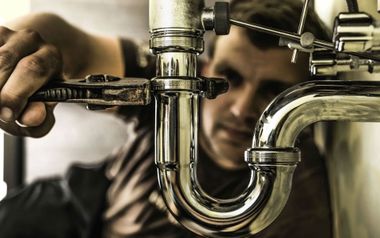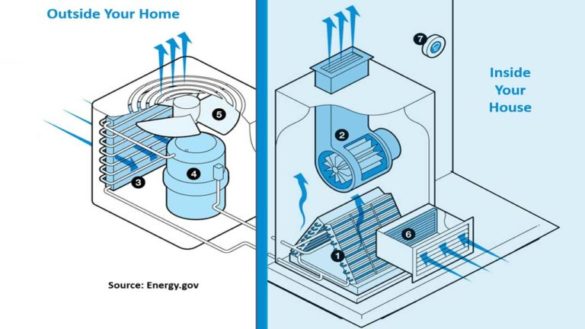An Overview to Your House's Plumbing System Anatomy
An Overview to Your House's Plumbing System Anatomy
Blog Article
Just about every person seems to have their own piece of advice involving The Inner Workings of Your Home's Plumbing.

Understanding exactly how your home's plumbing system works is important for every single house owner. From supplying tidy water for drinking, cooking, and showering to securely eliminating wastewater, a properly maintained plumbing system is important for your family's health and convenience. In this detailed guide, we'll discover the intricate network that makes up your home's plumbing and offer suggestions on upkeep, upgrades, and managing usual concerns.
Introduction
Your home's plumbing system is more than just a network of pipes; it's a complex system that guarantees you have accessibility to tidy water and reliable wastewater elimination. Understanding its elements and exactly how they collaborate can assist you prevent costly repairs and make certain everything runs efficiently.
Standard Parts of a Pipes System
Pipelines and Tubing
At the heart of your plumbing system are the pipes and tubing that bring water throughout your home. These can be made of different products such as copper, PVC, or PEX, each with its advantages in terms of longevity and cost-effectiveness.
Components: Sinks, Toilets, Showers, and so on.
Components like sinks, commodes, showers, and bath tubs are where water is used in your home. Understanding how these fixtures connect to the plumbing system helps in identifying issues and planning upgrades.
Valves and Shut-off Points
Valves control the flow of water in your plumbing system. Shut-off shutoffs are crucial during emergencies or when you need to make repairs, allowing you to isolate parts of the system without disrupting water circulation to the whole home.
Water System
Key Water Line
The primary water line links your home to the community supply of water or a personal well. It's where water enters your home and is dispersed to numerous components.
Water Meter and Pressure Regulator
The water meter steps your water usage, while a pressure regulator makes certain that water moves at a secure pressure throughout your home's plumbing system, preventing damages to pipelines and components.
Cold Water vs. Hot Water Lines
Understanding the difference between cold water lines, which supply water straight from the primary, and hot water lines, which carry warmed water from the hot water heater, assists in troubleshooting and preparing for upgrades.
Drain System
Drain Pipes Water Lines and Traps
Drain pipelines bring wastewater far from sinks, showers, and bathrooms to the sewer or septic tank. Traps avoid drain gases from entering your home and likewise trap debris that could cause blockages.
Air flow Pipelines
Air flow pipelines enable air into the drainage system, avoiding suction that can reduce water drainage and trigger traps to empty. Proper air flow is crucial for keeping the honesty of your pipes system.
Value of Appropriate Drain
Making certain correct drain avoids backups and water damage. Regularly cleaning drains and maintaining catches can protect against expensive repair work and extend the life of your pipes system.
Water Heating Unit
Types of Hot Water Heater
Hot water heater can be tankless or conventional tank-style. Tankless heating systems heat water as needed, while storage tanks save heated water for instant usage.
How Water Heaters Connect to the Pipes System
Understanding exactly how hot water heater connect to both the cold water supply and hot water circulation lines aids in identifying issues like insufficient warm water or leakages.
Maintenance Tips for Water Heaters
Frequently flushing your hot water heater to eliminate debris, checking the temperature setups, and evaluating for leakages can expand its life-span and improve energy effectiveness.
Usual Pipes Concerns
Leakages and Their Causes
Leaks can happen as a result of maturing pipelines, loose installations, or high water pressure. Dealing with leaks immediately protects against water damage and mold and mildew development.
Obstructions and Clogs
Clogs in drains and toilets are typically triggered by flushing non-flushable products or an accumulation of grease and hair. Utilizing drain screens and being mindful of what goes down your drains can avoid blockages.
Indications of Plumbing Problems to Expect
Low water pressure, sluggish drains, foul odors, or uncommonly high water expenses are indicators of potential plumbing issues that need to be dealt with immediately.
Pipes Upkeep Tips
Routine Examinations and Checks
Set up yearly plumbing inspections to catch problems early. Try to find indicators of leakages, corrosion, or mineral accumulation in faucets and showerheads.
Do It Yourself Maintenance Tasks
Basic jobs like cleansing tap aerators, checking for commode leakages using dye tablets, or insulating exposed pipelines in cold climates can prevent major plumbing problems.
When to Call a Professional Plumbing
Know when a plumbing issue requires professional competence. Trying complicated repair work without proper expertise can cause more damages and higher repair costs.
Updating Your Pipes System
Reasons for Updating
Upgrading to water-efficient fixtures or changing old pipes can enhance water quality, lower water expenses, and enhance the value of your home.
Modern Pipes Technologies and Their Benefits
Discover innovations like clever leak detectors, water-saving toilets, and energy-efficient hot water heater that can save cash and minimize environmental influence.
Cost Considerations and ROI
Compute the in advance prices versus long-lasting financial savings when thinking about plumbing upgrades. Lots of upgrades spend for themselves via decreased utility costs and fewer fixings.
Ecological Impact and Preservation
Water-Saving Fixtures and Appliances
Installing low-flow faucets, showerheads, and bathrooms can dramatically decrease water use without sacrificing performance.
Tips for Minimizing Water Usage
Easy habits like repairing leakages immediately, taking shorter showers, and running full loads of washing and recipes can preserve water and reduced your energy costs.
Eco-Friendly Plumbing Options
Consider sustainable plumbing materials like bamboo for floor covering, which is durable and environment-friendly, or recycled glass for countertops.
Emergency Readiness
Actions to Take Throughout a Pipes Emergency
Know where your shut-off valves are located and just how to switch off the water system in case of a ruptured pipeline or major leak.
Value of Having Emergency Calls Convenient
Maintain get in touch with information for local plumbing technicians or emergency solutions conveniently available for fast reaction throughout a plumbing dilemma.
DIY Emergency Fixes (When Relevant).
Short-lived repairs like making use of duct tape to patch a dripping pipe or putting a container under a trickling faucet can lessen damages up until a specialist plumbing professional shows up.
Verdict.
Recognizing the makeup of your home's pipes system equips you to preserve it properly, conserving time and money on repair work. By complying with normal upkeep regimens and remaining notified concerning modern-day pipes technologies, you can ensure your pipes system operates efficiently for years to come.
HOW YOUR PLUMBING SYSTEM WORKS
Which Pipes Do What?
Blue lines = fresh water supply entering the building
Red lines = hot water supply entering the building
Grey lines = pipes carrying waste away from the building and venting pipes carrying gases away from the building (through the roof)
YOUR MAIN PLUMBING SYSTEMS
There are two main plumbing systems that support your home s basic plumbing needs one that brings clean water into your home, and one that sends dirty water away from your home. Connected to the toilet, bath, shower, and other faucets in your home, these two systems keep your water flowing in the right directions.
ACCESSING FRESH WATER
Fresh and clean water is brought into your home through the main water supply line . Filtered through one pipe, this water is pressured to flow into the various fixtures in your home at any given time.
This water can be sourced from a well located on your property, a pond or river (mostly cottages), or, as in most cases, from the city s municipal water treatment centre. However, it is important to note that water that is untreated, such as the water siphoned from ponds or rivers, may not be safe to drink. Personal water supplies always need to be treated for hardness and contaminants before consumed.
MUNICIPAL WATER SUPPLIES
Improve taste and odour
Remove sediment
Eliminate hardness
Reduce chlorine
COLD WATER SUPPLY VS. HOT WATER SUPPLY
Cold water flows into your home or building through the service line, which then distributes hot or cold water to your fixtures. This line is most commonly run through a central column that runs floor to floor. Hot water runs in short and straight pipes as the longer the pipeline, the more heat that will be lost in the transfer. Having shorter pipes also allows residents to access hot water more quickly.
WASTE WATER SYSTEM
Your wastewater system is divided into two parts pipes that send wastewater away from your home and venting pipes that send sewer gas away from your home. Sewage water travels through pipes that flush the water and waste towards local sewers that are operated and managed by your city or town. Most sewer systems rely on gravity to move the wastewater to where it needs to go.
The further away from your toilet or sink, the larger wastewater pipes become. This allows for waste to be disposed of from various parts of your home or business at once without pipe blockages. The angle and flow of these pipes are also essential for keeping your waste pipes clear of build up.
https://harrisplumbing.ca/how-your-home-plumbing-system-works/

HOW YOUR PLUMBING SYSTEM WORKS
Which Pipes Do What?
YOUR MAIN PLUMBING SYSTEMS
There are two main plumbing systems that support your home s basic plumbing needs one that brings clean water into your home, and one that sends dirty water away from your home. Connected to the toilet, bath, shower, and other faucets in your home, these two systems keep your water flowing in the right directions.
ACCESSING FRESH WATER
Fresh and clean water is brought into your home through the main water supply line . Filtered through one pipe, this water is pressured to flow into the various fixtures in your home at any given time.
This water can be sourced from a well located on your property, a pond or river (mostly cottages), or, as in most cases, from the city s municipal water treatment centre. However, it is important to note that water that is untreated, such as the water siphoned from ponds or rivers, may not be safe to drink. Personal water supplies always need to be treated for hardness and contaminants before consumed.
MUNICIPAL WATER SUPPLIES
COLD WATER SUPPLY VS. HOT WATER SUPPLY
Cold water flows into your home or building through the service line, which then distributes hot or cold water to your fixtures. This line is most commonly run through a central column that runs floor to floor. Hot water runs in short and straight pipes as the longer the pipeline, the more heat that will be lost in the transfer. Having shorter pipes also allows residents to access hot water more quickly.
WASTE WATER SYSTEM
Your wastewater system is divided into two parts pipes that send wastewater away from your home and venting pipes that send sewer gas away from your home. Sewage water travels through pipes that flush the water and waste towards local sewers that are operated and managed by your city or town. Most sewer systems rely on gravity to move the wastewater to where it needs to go.
The further away from your toilet or sink, the larger wastewater pipes become. This allows for waste to be disposed of from various parts of your home or business at once without pipe blockages. The angle and flow of these pipes are also essential for keeping your waste pipes clear of build up.
https://harrisplumbing.ca/how-your-home-plumbing-system-works/
As a keen reader about Exploring Your Homes Plumbing Anatomy, I figured sharing that piece of content was a smart idea. Sharing is caring. Helping people is fun. Thanks a bunch for your time. Kindly pay a visit to our site back soon.
Pricing Report this page